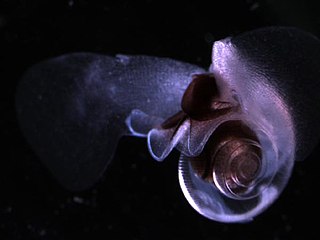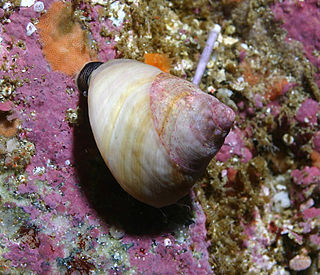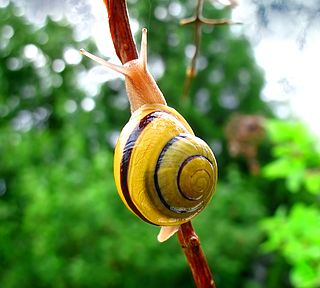Taxonomy
Class Gastropoda Cuvier, 1797
Incertæ sedis
- Order Bellerophontinaka (fossil)
- Order Mimospirina (fossil)
Subclass Eogastropoda Ponder & David R. Lindberg, 1996 (earlier: Prosobranchia)
- Order Euomphalida de Koninck 1881 (fossil)
- Superfamily Macluritoidea
- Superfamily Euomphaloidea
- Superfamily Platyceratoidea
- Order Patellogastropoda Lindberg, 1986 (true limpets)

- Suborder Patellina Van Ihering, 1876
- Superfamily Patelloidea Rafinesque, 1815
- Suborder Nacellina David R. Lindberg, 1988
- Superfamily Acmaeoidea Carpenter, 1857
- Superfamily Nacelloidea Thiele, 1891
- Suborder Lepetopsina McLean, 1990
- Superfamily Lepetopsoidea McLean, 1990
- Suborder Patellina Van Ihering, 1876
'Subclass Orthogastropoda Ponder & David R. Lindberg, 1996 (earlier Prosobranchia, Opisthobranchia)
Incertæ sedis
- Order Murchisoniina Cox & Knight, 1960 (fossil)
- Superfamily Murchisonioidea Koken, 1889
- Superfamily Loxonematoidea Koken, 1889
- Superfamily Lophospiroidea Wenz, 1938
- Superfamily Straparollinoidea
- Grade Subulitoidea Lindström, 1884
Superorder Cocculiniformia Haszprunar, 1987
- Superfamily Cocculinoidea Dall, 1882
- Superfamily Lepetelloidea Dall, 1882 (deep sea limpets)
Superorder "Hot Vent Taxa" Ponder & David R. Lindberg, 1997
- Order Neomphaloida Sitnikova & Starobogatov, 1983
- Superfamily Neomphaloidea McLean, 1981 (hydrothermal vents limpets)
- Superfamily Peltospiroidea McLean, 1989
Superorder Vetigastropoda Salvini-Plawen, 1989 (limpets)

- Superfamily Fissurelloidea Fleming, 1822 (keyhole limpets)
- Superfamily Haliotoidea Rafinesque, 1815 (abalones)
- Superfamily Lepetodriloidea McLean, 1988 (hydrothermal vent limpets)
- Superfamily Pleurotomarioidea Swainson, 1840 (slit shells)
- Superfamily Seguenzioidea Verrill, 1884
- Superfamily Trochoidea Rafinesque, 1815 (top shells)
Superorder Neritaemorphi Koken, 1896
- Order Cyrtoneritomorpha (fossil)
- Order Neritopsina Cox & Knight, 1960
- Superfamily Neritoidea Lamarck, 1809
Superorder Caenogastropoda Cox, 1960
- Order Architaenioglossa Haller, 1890
- Superfamily Ampullarioidea J.E. Gray, 1824
- Superfamily Cyclophoroidea J.E. Gray, 1847 (terrestrials)
- Order Sorbeoconcha Ponder & David R. Lindberg, 1997
- Suborder Discopoda P. Fischer, 1884
- Superfamily Campaniloidea Douvillé, 1904
- Superfamily Cerithioidea Férussac, 1822
- Suborder Hypsogastropoda Ponder & David R. Lindberg, 1997
- Infraorder Littorinimorpha Golikov & Starobogatov, 1975
- Superfamily Calyptraeoidea Lamarck, 1809
- Superfamily Capuloidea J. Fleming, 1822
- Superfamily Carinarioidea Blainville, 1818 (formerly called Heteropoda)
- Superfamily Cingulopsoidea Fretter & Patil, 1958
- Superfamily Cypraeoidea Rafinesque, 1815 (cowries)
- Superfamily Ficoidea Meek, 1864
- Superfamily Laubierinoidea Warén & Bouchet, 1990
- Superfamily Littorinoidea (Children), 1834 (periwinkles)
- Superfamily Naticoidea Forbes, 1838 (moon shells)
- Superfamily Rissooidea J.E. Gray, 1847 (Risso shells) (includes genus Oncomelania , schistosomiasis transmission vector)
- Superfamily Stromboidea Rafinesque, 1815 (true conchs)
- Superfamily Tonnoidea Suter, 1913
- Superfamily Trivioidea Troschel, 1863
- Superfamily Vanikoroidea J.E. Gray, 1840
- Superfamily Velutinoidea J.E. Gray, 1840
- Superfamily Vermetoidea Rafinesque, 1815 (worm shells)
- Superfamily Xenophoroidea Troschel, 1852 (carrier shells)
- Infraorder Ptenoglossa J.E. Gray, 1853
- Superfamily Eulimoidea Philippi, 1853
- Superfamily Janthinoidea Lamarck, 1812
- Superfamily Triphoroidea J.E. Gray, 1847
- Infraorder Neogastropoda Thiele, 1929
- Superfamily Buccinoidea (whelks, false tritions)
- Superfamily Cancellarioidea Forbes & Hanley, 1851
- Superfamily Conoidea Rafinesque, 1815
- Superfamily Muricoidea Rafinesque, 1815
- Suborder Discopoda P. Fischer, 1884
Superorder Heterobranchia J.E. Gray, 1840
- Order Heterostropha P. Fischer, 1885
- Superfamily Architectonicoidea J.E. Gray, 1840
- Superfamily Nerineoidea Zittel, 1873 (fossil)
- Superfamily Omalogyroidea G.O. Sars, 1878
- Superfamily Pyramidelloidea J.E. Gray, 1840
- Superfamily Rissoelloidea J.E. Gray, 1850
- Superfamily Valvatoidea J.E. Gray, 1840
- Order Opisthobranchia Milne-Edwards, 1848
- Suborder Cephalaspidea P. Fischer, 1883
- Superfamily Acteonoidea D'Orbigny, 1835
- Superfamily Bulloidea Lamarck, 1801
- Superfamily Cylindrobulloidea Thiele, 1931 (has to be included in the Sacoglossa)
- Superfamily Diaphanoidea Odhner, 1914
- Superfamily Haminoeoidea Pilsbry, 1895
- Superfamily Philinoidea J.E. Gray, 1850
- Superfamily Ringiculoidea Philippi, 1853
- Suborder Sacoglossa Von Ihering, 1876
- Superfamily Oxynooidea H. Adams & A. Adams, 1854
- Suborder Anaspidea P. Fischer, 1883 (sea hares)
- Superfamily Akeroidea Pilsbry, 1893
- Superfamily Aplysioidea Lamarck, 1809
- Suborder Notaspidea P. Fischer, 1883
- Superfamily Tylodinoidea J.E. Gray, 1847
- Superfamily Pleurobranchoidea Férussac, 1822
- Suborder Thecosomata Blainville, 1824 (sea butterflies)
- Infraorder Euthecosomata
- Superfamily Limacinoidea
- Superfamily Cavolinioidea
- Infraorder Pseudothecosomata
- Superfamily Peraclidoidea
- Superfamily Cymbulioidea
- Infraorder Euthecosomata
- Suborder Gymnosomata Blainville, 1824 (sea angels)
- Family Clionidae Rafinesque, 1815
- Family Cliopsidae Costa, 1873
- Family Hydromylidae Pruvot-Fol, 1942
- Family Laginiopsidae Pruvot-Fol, 1922
- Family Notobranchaeidae Pelseneer, 1886
- Family Pneumodermatidae Latreille, 1825
- Family Thliptodontidae Kwietniewski, 1910
- Suborder Cephalaspidea P. Fischer, 1883

- Suborder Nudibranchia Blainville, 1814 (nudibranchs)
- Infraorder Anthobranchia Férussac, 1819
- Superfamily Doridoidea Rafinesque, 1815
- Superfamily Doridoxoidea Bergh, 1900
- Superfamily Onchidoridoidea Alder & Hancock, 1845
- Superfamily Polyceroidea Alder & Hancock, 1845
- Infraorder Cladobranchia Willan & Morton, 1984
- Superfamily Dendronotoidea Allman, 1845
- Superfamily Arminoidea Rafinesque, 1814
- Superfamily Metarminoidea Odhner in Franc, 1968
- Superfamily Aeolidioidea J.E. Gray, 1827
- Order Pulmonata Cuvier in Blainville, 1814 (pulmonates)
- Suborder Systellommatophora Pilsbry, 1948
- Superfamily Onchidioidea Rafinesque, 1815
- Superfamily Otinoidea H. Adams & A. Adams, 1855
- Superfamily Rathouisioidea Sarasin, 1889
- Suborder Basommatophora Keferstein in Bronn, 1864 (freshwater pulmonates, pond snails)
- Superfamily Acroloxoidea Thiele, 1931
- Superfamily Amphiboloidea J.E. Gray, 1840
- Superfamily Chilinoidea H. Adams & A. Adams, 1855
- Superfamily Glacidorboidea Ponder, 1986
- Superfamily Lymnaeoidea Rafinesque, 1815
- Superfamily Planorboidea Rafinesque, 1815
- Superfamily Siphonarioidea J.E. Gray, 1840
- Suborder Eupulmonata Haszprunar & Huber, 1990
- Infraorder Acteophila Dall, 1885 (= formerly Archaeopulmonata)
- Superfamily Melampoidea Stimpson, 1851
- Infraorder Trimusculiformes Minichev & Starobogatov, 1975
- Superfamily Trimusculoidea Zilch, 1959
- Infraorder Stylommatophora A. Schmidt, 1856 (land snails)
- Subinfraorder Orthurethra
- Superfamily Achatinelloidea Gulick, 1873
- Superfamily Cochlicopoidea Pilsbry, 1900
- Superfamily Partuloidea Pilsbry, 1900
- Superfamily Pupilloidea Turton, 1831
- Subinfraorder Sigmurethra
- Superfamily Acavoidea Pilsbry, 1895
- Superfamily Achatinoidea Swainson, 1840
- Superfamily Aillyoidea Baker, 1960
- Superfamily Arionoidea J.E. Gray in Turnton, 1840
- Superfamily Buliminoidea Clessin, 1879
- Superfamily Camaenoidea Pilsbry, 1895
- Superfamily Clausilioidea Mörch, 1864
- Superfamily Dyakioidea Gude & Woodward, 1921
- Superfamily Gastrodontoidea Tryon, 1866
- Superfamily Helicoidea Rafinesque, 1815
- Superfamily Helixarionoidea Bourguignat, 1877
- Superfamily Limacoidea Rafinesque, 1815
- Superfamily Oleacinoidea H. Adams & A. Adams, 1855
- Superfamily Orthalicoidea Albers-Martens, 1860
- Superfamily Plectopylidoidea Moellendorf, 1900
- Superfamily Polygyroidea Pilsbry, 1894
- Superfamily Punctoidea Morse, 1864
- Superfamily Rhytidoidea Pilsbry, 1893
- Superfamily Sagdidoidea Pilsbry, 1895
- Superfamily Staffordioidea Thiele, 1931
- Superfamily Streptaxoidea J.E. Gray, 1806
- Superfamily Strophocheiloidea Thiele, 1926
- Superfamily Trigonochlamydoidea Hese, 1882
- Superfamily Zonitoidea Mörch, 1864
- ? Superfamily Athoracophoroidea P. Fischer, 1883 (= Tracheopulmonata)
- ? Superfamily Succineoidea Beck, 1837 (= Heterurethra)
- Suborder Systellommatophora Pilsbry, 1948
Other extant classes of the Mollusca are Bivalvia, Scaphopoda, Aplacophora, Polyplacophora, Monoplacophora and Cephalopoda.















